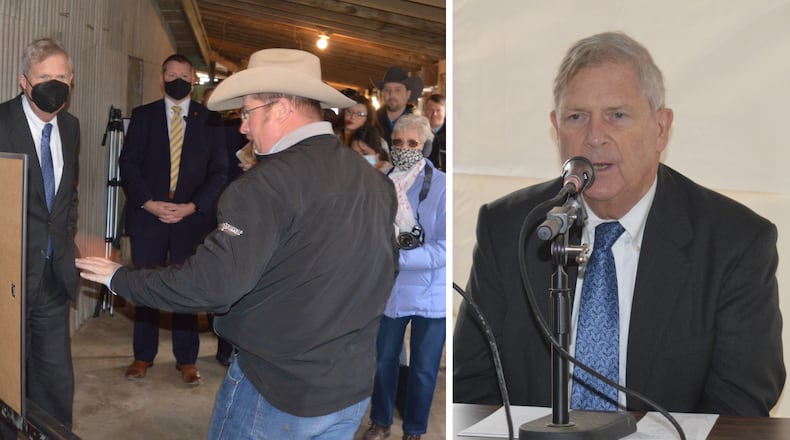Following the tour of the facility, Vilsack made a formal announcement of the third phase of a program to improve the supply chain with a loan guarantee program to help with projects like what the Korbs are building.
“The pandemic exposed vulnerabilities and created extreme disruptions in America’s food supply chain. The reduction in meat processing capacity is just one example of the supply chain bottlenecks that affect small and midsize farmers,” Vilsack said. “Under the leadership of President Biden and Vice President Harris, USDA is investing in ways to improve America’s food supply chain. The funding we’re announcing today (Thursday) will leverage approximately a billion dollars in public and private-sector investments that will significantly expand meat and poultry processing capacity and finance critical food supply chain infrastructure.”
He said the first part of the effort was in response to processing plants around the country struggling to pay overtime to employees due to the increased demand for meat products caused by the pandemic. He said that phase helped 2,300 businesses reduce production costs and stay in business.
The second part was $32 million in grants to help processing businesses with the inspection expenses imposed by federal regulations due to interstate operation.
“The third step is a $100 million loan guarantee program. We say to banks we will guarantee repayment of the loan up to 90 percent of the loan. That will reduce the risk lenders may have with a business getting started,” Vilsack said. “It will make banks more competitive making loans. Banks may be apprehensive about such loans without much knowledge of the processing business.”
He said that $100 million figure is actually only the base money, but as money is reused it will make the useful amount of the fund potentially as high as $500 million.
Vilsack said they can begin immediately to take requests for use of the program and said there will be a program Dec. 14 for banks to learn more about the guarantee program.
He said the announcement was made at the Korbs’ farm because they plan the type of facility needed in the country and the fund was designed to help — a young family trying to create jobs and build the food supply chain.
“We have heard we need more capacity. We need better facilities to get cattle processed,” Vilsack said. “We’ve got to have multiple size facilities. We need more small operations.”
He explained the larger meat processors require larger animals due to the equipment they have, but when one shuts down, the smaller processors are not equipped to handle such large animals.
This funding announcement follows the Biden-Harris administration’s September announcement about the steps it is taking to address concentration in the meat-processing industry. It adds a new commitment of $100 million for guaranteed loans on top of the previously announced $500 million investment to expand meat and poultry processing capacity.
As co-chair of the Biden-Harris administration’s Supply Chain Disruptions Task Force, Vilsack and the USDA have brought together industry, labor and federal partners to address the short-term supply chain disruptions arising from the administration’s economic recovery. This is one of several steps that the USDA is taking to build a more resilient supply chain and better food system and to increase competition in agricultural markets, Vilsack said.
During his tour of the existing facility, Andy Korb said they purchased the farm a year-and-a-half ago and the building was built in 1953, but the original building on the site was built in the late 1800s. The current barn was a state-of-the-art hog feeding facility with heated concrete floors.
His plans for the new building were on display for Vilsack and others to view. He said the first plan submitted to the county was rejected but that is normal, Korb said, explaining it is usually three submissions before gaining acceptance.
He said they are hoping for a January ground breaking.
About the Author
